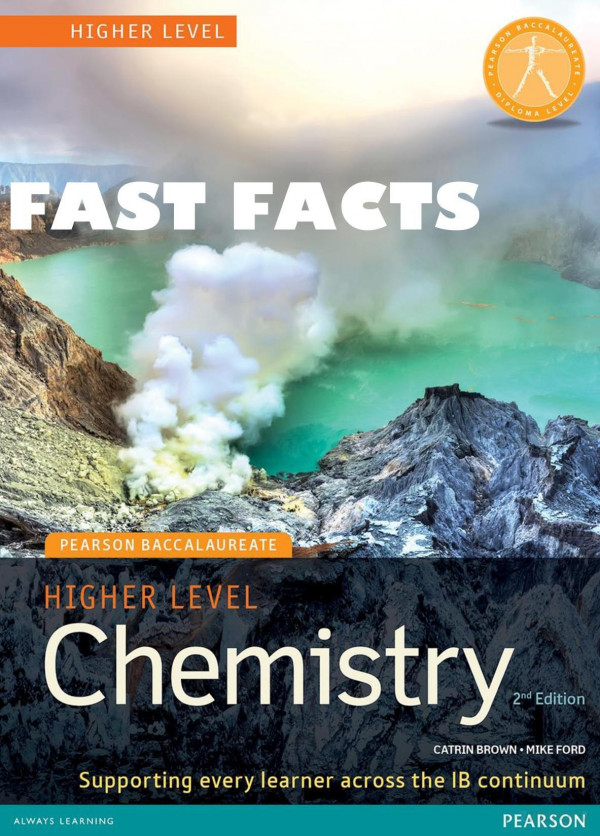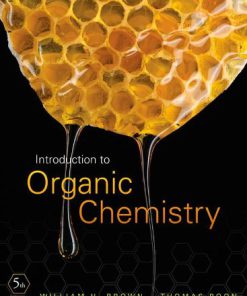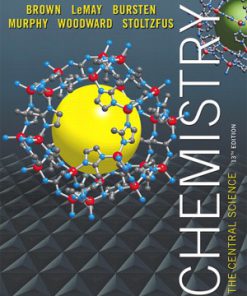Chemistry 2nd Edition by Catrin Brown 1447959752 9781447959755
$50.00 Original price was: $50.00.$25.00Current price is: $25.00.
Chemistry 2nd Edition by Catrin Brown – Ebook PDF Instant Download/Delivery: 1447959752, 9781447959755
Full download Chemistry 2nd Edition Editionfter payment

Product details:
• ISBN 10:1447959752
• ISBN 13:9781447959755
• Author:Catrin Brown
Significantly revised editions of the Group 4 Science titles in the Pearson Baccalaureate series, matched to the latest IB specification (2014). Fully comprehensive and IB specific, including enhanced eText access, with animations, videos, quizzes, worksheets and other interactive content. Written by respected authors in the IB world, and forming part of a comprehensive offering for the IB Diploma.
Chemistry 2nd Table of contents:
1: What Is Chemistry?
What is chemistry? Simply put, chemistry is the study of the interactions of matter with other matter and with energy. This seems straightforward enough. However, the definition of chemistry includes a wide range of topics that must be understood to gain a mastery of the topic or even take additional courses in chemistry. In this book, we will lay the foundations of chemistry in a topic-by-topic fashion to provide you with the background you need to successfully understand chemistry.
1.1: Prelude to Chemistry
1.2: Basic Definitions
1.3: Chemistry as a Science
1.4: What Is Chemistry? (Exercises)
2: Measurements
Chemistry, like all sciences, is quantitative. It deals with quantities, things that have amounts and units. Dealing with quantities is very important in chemistry, as is relating quantities to each other. In this chapter, we will discuss how we deal with numbers and units, including how they are combined and manipulated.
2.1: Prelude to Measurements
2.2: Expressing Numbers
2.3: Expressing Units
2.4: Significant Figures
2.5: Converting Units
2.6: Other Units – Temperature and Density
2.7: Measurements (Exercises)
3: Atoms, Molecules, and Ions
The basic building block of all matter is the atom. Curiously, the idea of atoms was first proposed in the fifth century BCE, when the Greek philosophers Leucippus and Democritus proposed their existence in a surprisingly modern fashion. However, their ideas never took hold among their contemporaries, and it wasn’t until the early 1800s that evidence amassed to make scientists reconsider the idea. Today, the concept of the atom is central to the study of matter.
3.1: Prelude to Atoms, Molecules, and Ions
3.2: Atomic Theory
3.3: Molecules and Chemical Nomenclature
3.4: Masses of Atoms and Molecules
3.5: Ions and Ionic Compounds
3.6: Acids
3.7: Atoms, Molecules, and Ions (Exercises)
3: Atoms, Molecules and Ions (Exercises)
Monotomic Ions of Various Charges
4: Chemical Reactions and Equations
Chemistry is largely about chemical changes. Indeed, if there were no chemical changes, chemistry as such would not exist! Chemical changes are a fundamental part of chemistry. Because chemical changes are so central, it may be no surprise that chemistry has developed some special ways of presenting them.
4.1: Prelude to Chemical Reactions
4.2: The Chemical Equation
4.3: Types of Chemical Reactions – Single and Double Displacement Reactions
4.4: Ionic Equations – A Closer Look
4.5: Composition, Decomposition, and Combustion Reactions
4.6: Neutralization Reactions
4.7: Chemical Reactions and Equations (Exercises)
5: Stoichiometry and the Mole
We have already established that quantities are important in science, especially in chemistry. It is important to make accurate measurements of a variety of quantities when performing experiments. However, it is also important to be able to relate one measured quantity to another, unmeasured quantity. In this chapter, we will consider how we manipulate quantities to relate them to each other.
5.1: Introduction
5.2: Stoichiometry
5.4: Determining Empirical and Molecular Formulas
5.3: The Mole
5.5: The Mole in Chemical Reactions
5.6: Mole-Mass and Mass-Mass Calculations
5.7: Determining Empirical and Molecular Formulas
5.8: Yields
5.9: Limiting Reagents
5.10: Stoichiometry and the Mole (Exercises)
6: Gases
Gases have no definite shape or volume; they tend to fill whatever container they are in. They can compress and expand, sometimes to a great extent. Gases have extremely low densities, one-thousandth or less the density of a liquid or solid. Combinations of gases tend to mix together spontaneously; that is, they form solutions. Air, for example, is a solution of mostly nitrogen and oxygen. Any understanding of the properties of gases must be able to explain these characteristics.
6.1: Prelude to Gases
6.2: Kinetic Theory of Gases
6.3: Gas Pressure
6.4: Gas Laws
6.5: Other Gas Laws
6.6: The Ideal Gas Law and Some Applications
6.7: Gas Mixtures
6.8: Gases (Exercises)
7: Energy and Chemistry
Energy is a very important quantity in science and the world around us. Although most of our energy ultimately comes from the sun, much of the energy we use on a daily basis is rooted in chemical reactions. The gasoline in your car, the electricity in your house, the food in your diet – all provide substances for chemical reactions to provide energy (gasoline, food) or are produced from chemical reactions (electricity, about 50% of which is generated by burning coal).
7.1: Introduction
7.2: Energy
7.3: Internal Energy, Work and Heat
7.4: Enthalpy and Chemical Reactions
7.5 Conservation of Energy and the Internal Energy of a System
7.6: Energy and Chemistry (Exercises)
8: Electronic Structure
Atoms act the way they do because of their structure. We already know that atoms are composed of protons, neutrons, and electrons. Protons and neutrons are located in the nucleus, and electrons orbit around the nucleus. But we need to know the structural details to understand why atoms react the way they do. Virtually everything we know about atoms ultimately comes from light. Before we can understand the composition of atoms (especially electrons), we need to understand the properties of light.
8.1: Prelude to Electronic Structure
8.2: Light
8.3: Quantum Numbers for Electrons
8.4: Organization of Electrons in Atoms
8.5: Electronic Structure and the Periodic Table
8.6: Periodic Trends
8.7: Electronic Structure (Exercises)
9: Chemical Bonds
How do atoms make compounds? Typically they join together in such a way that they lose their identities as elements and adopt a new identity as a compound. These joins are called chemical bonds. But how do atoms join together? Ultimately, it all comes down to electrons. Before we discuss how electrons interact, we need to introduce a tool to simply illustrate electrons in an atom.
9.1: Prelude to Chemical Bonds
9.2: Lewis Electron Dot Diagrams
9.3: Electron Transfer – Ionic Bonds
9.4: Covalent Bonds
9.5: Violations of the Octet Rule
9.6: Bond Polarity
9.7: Molecular Shapes
9.8: Polar Molecules
9.9: Chemical Bonds (Exercises)
10: Solutions
A solution is a homogeneous mixture—a mixture of two or more substances that are so intimately mixed that the mixture behaves in many ways like a single substance. Many chemical reactions occur when the reactants are dissolved in solution. In this chapter, we will introduce concepts that are applicable to solutions and the chemical reactions that occur in them.
10.1: Prelude to Solutions
10.2: Definitions
10.3: Quantitative Units of Concentration
10.4: Dilutions and Concentrations
10.5: Concentrations as Conversion Factors
10.6: Solutions (Exercises)
11: Acids and Bases
Acids and bases are important classes of chemical compounds. They are part of the foods and beverages we ingest, they are present in medicines and other consumer products, and they are prevalent in the world around us. In this chapter, we will focus on acids and bases and their chemistry.
11.1: Introduction
11.2: Arrhenius Acids and Bases
11.3: Brønsted-Lowry Acids and Bases
11.4: Acid-Base Titrations
11.5: Strong and Weak Electrolytes
11.6: Strong and Weak Acids and Bases and their Salts
11.7: Autoionization of Water
11.8: The pH Scale
11.9: Acids and Bases (Exercises)
12: Oxidation and Reduction
One important type of chemical reaction is the oxidation-reduction reaction, also known as the redox reaction.
12.1: Introduction to Oxidation and Reduction
12.2: Oxidation-Reduction Reactions
12.3: Balancing Redox Reactions
12.4: Oxidation-Reduction Reaction (Exercises)
13: Nuclear Chemistry
In nuclear chemistry, the composition of the nucleus and the changes that occur there are very important. Applications of nuclear chemistry may be more widespread than you realize. Many people are aware of nuclear power plants and nuclear bombs, but nuclear chemistry also has applications ranging from smoke detectors to medicine. In this chapter, we will examine some of the basic concepts of nuclear chemistry and some of the nuclear reactions that are important in our everyday lives.
13.1: Prelude to Nuclear Chemistry
13.2: Radioactivity
13.3: Uses of Radioactive Isotopes
13.4: Nuclear Chemistry (Exercises)
14: Chemistry of Life: Organic and Biological Chemistry
Organic chemistry involves the scientific study of the structure, properties, and reactions of organic compounds and organic materials, i.e., matter in its various forms that contain carbon atoms. Organic compounds form the basis of all earthly life and constitute a significant part of human endeavors in chemistry.
14.1: General Characteristics of Organic Molecules
14.2: Introduction to Hydrocarbons
14.3: Alkanes
14.4: Unsaturated Hydrocarbons
14.5: Functional Groups
14.6: Organic and Biological Chemistry (Summary)
Back Matter
Index
Glossary
People also search for Chemistry 2nd:
chemistry 2nd edition
chemistry 2nd edition openstax
aqa chemistry 2nd edition answers
organic chemistry 2nd edition pdf
apologia chemistry 2nd edition
You may also like…
Chemistry - Chemistry - General & Miscellaneous
Chemistry - Organic Chemistry
Introduction to Organic Chemistry 5th Edition William H. Brown
Politics & Philosophy - Social Sciences
Feminist Therapy 2nd Edition by Laura S Brown ISBN 9781433829116 1433829118
Chemistry
Uncategorized
Chemistry - Organic Chemistry
Chemistry - Chemistry - General & Miscellaneous
Chemistry The Central Science 13th Edition by Theodore Brown, Eugene LeMay 1484258170 9781484258170
Chemistry - Organic Chemistry
Organic Chemistry 8th Edition William 1305865596 9781305865594
Relationships & Lifestyle - Exercise & Fitness












